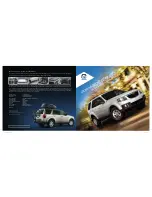
CAUTION!
(Continued)
•
To avoid fuel spillage and overfilling, do not “top
off” the fuel tank after filling.
NOTE:
•
When the fuel nozzle “clicks” or shuts off, the fuel tank
is full.
•
Tighten the fuel filler cap until you hear a “clicking”
sound. This is an indication that the fuel filler cap is
properly tightened.
•
If the gas cap is not tightened properly, the MIL may
come on. Be sure the gas cap is tightened every time the
vehicle is refueled.
VEHICLE LOADING
As required by National Highway Traffic Safety Adminis-
tration regulations, your vehicle has a certification label
affixed to the driver’s side door or B-Pillar.
If seats are removed for carrying cargo, do not exceed the
specified GVWR and GAWR.
Vehicle Certification Label
Your vehicle has a Vehicle Certification Label affixed to the
drivers side B-Pillar or the rear of the driver’s door.
The label contains the following information:
•
Name of manufacturer
•
Month and year of manufacture
•
Gross Vehicle Weight Rating (GVWR)
•
Gross Axle Weight Rating (GAWR) front
•
Gross Axle Weight Rating (GAWR) rear
•
Vehicle Identification Number (VIN)
•
Type of vehicle
•
Month, Day, and Hour of manufacture (MDH)
The bar code allows a computer scanner to read the VIN.
Gross Vehicle Weight Rating (GVWR)
The GVWR is the total allowable weight of your vehicle.
This includes driver, passengers, and cargo. The total load
must be limited so that you do not exceed the GVWR.
240
STARTING AND OPERATING
Summary of Contents for promaster city 2017
Page 4: ......
Page 7: ...1 INTRODUCTION 5 ...
Page 10: ......
Page 76: ......
Page 120: ......
Page 124: ...INSTRUMENT CLUSTER Instrument Cluster 122 UNDERSTANDING YOUR INSTRUMENT PANEL ...
Page 184: ......
Page 318: ...Fuse Panel Cavity Locations 316 MAINTAINING YOUR VEHICLE ...
Page 332: ......
Page 333: ...MAINTENANCE SCHEDULES CONTENTS 䡵 MAINTENANCE SCHEDULE 332 Maintenance Chart 333 8 ...
Page 338: ......
Page 345: ...INDEX 10 ...
















































